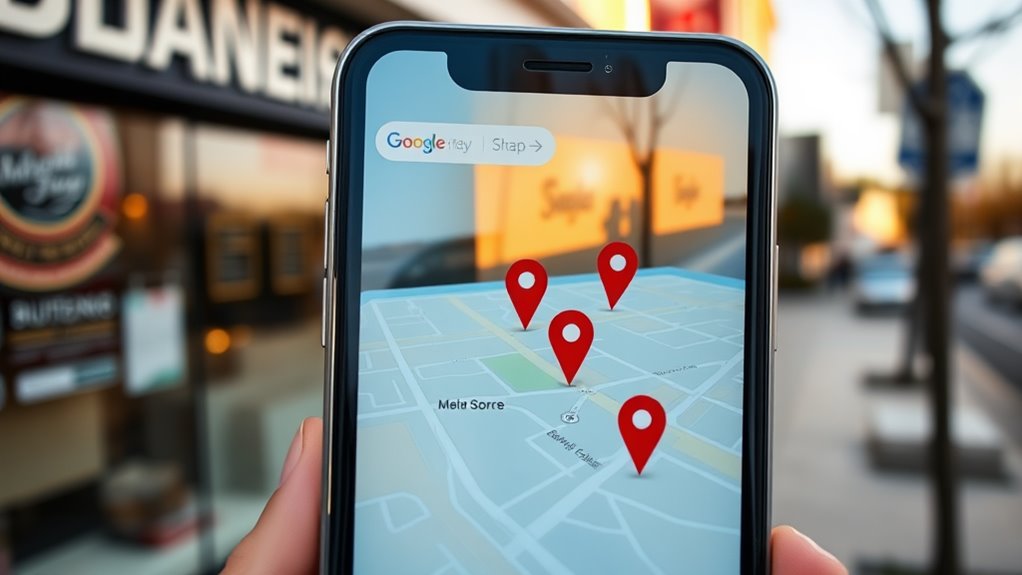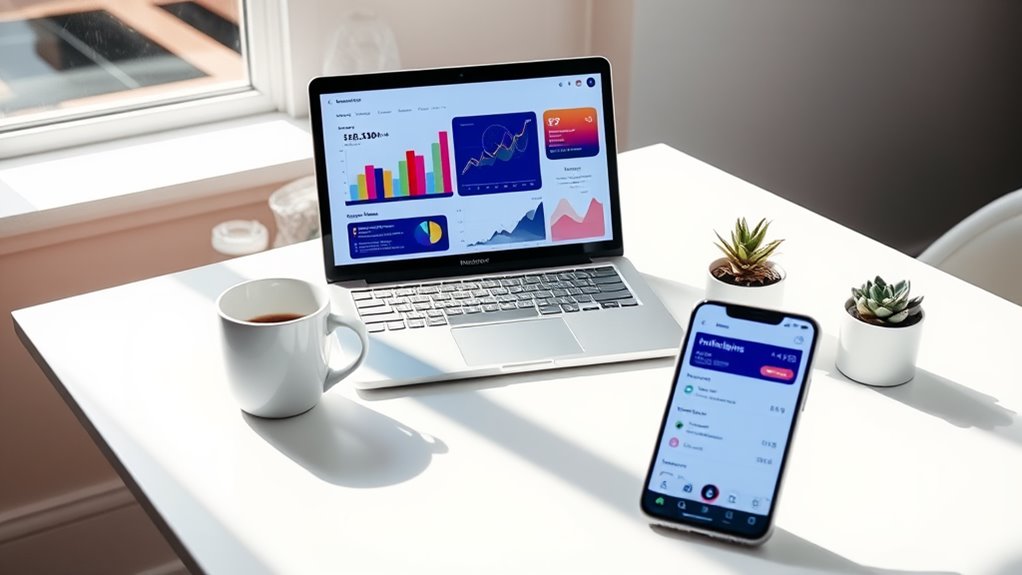To optimize your local SEO on Google, start by claiming and optimizing your Google Business Profile, which influences 76% of local searches leading to same-day visits. You'll need to build consistent local citations across directories, ensuring your NAP (Name, Address, Phone) information matches everywhere. Focus on optimizing your website with location-specific keywords, creating area-specific landing pages, and implementing proper schema markup. Don't forget to actively generate and manage customer reviews, as 87% of consumers rely on them before choosing a business. Building quality local backlinks through community engagement and partnerships will strengthen your local search presence. The following strategies will help you master each essential component.
Key Takeaway
- Claim and optimize your Google Business Profile with accurate business information, photos, and regular updates to improve local visibility.
- Build consistent citations across directories with matching NAP (Name, Address, Phone) information to strengthen local authority.
- Optimize your website with location-based keywords in titles, meta descriptions, and content while maintaining natural readability.
- Actively collect and respond to customer reviews on Google Business Profile, maintaining professionalism in all interactions.
- Implement local business schema markup and build quality backlinks from community organizations and local business partners.
Claim Your Google Business Profile
Claiming your Google Business Profile stands as the foundation of local SEO success. When you take control of your listing, you're establishing your business's digital footprint and ensuring accurate information reaches potential customers in your area.
Steps to Claim Your Profile:
- Search for your business on Google Maps
- Click "Claim this business" or "Own this business?"
- Choose your verification method (postcard, phone, or email)
- Complete the verification process within 30 days
Essential Profile Optimization:
- Business name exactly as it appears on your storefront
- Complete address with suite/unit numbers
- Primary phone number that connects directly to your business
- Accurate business hours, including holiday schedules
- Primary business category plus relevant secondary categories
- High-quality photos of your business (minimum 10)
- Thorough business description (250+ words)
Remember to maintain your profile by:
- Responding to customer reviews within 24-48 hours
- Updating seasonal hours promptly
- Posting weekly updates about products, services, or events
- Monitoring profile insights to track customer engagement
- Correcting any inaccurate information immediately
Your Google Business Profile serves as your digital storefront, influencing 76% of local searches that result in same-day store visits.
Build Local Citations
Beyond your Google Business Profile, local citations form a network of digital references that validate your business's existence and authority. These citations, which include your business name, address, and phone number (NAP), appear across various online platforms and directories.
Key Citation Sources to Target:
- Industry-specific directories (e.g., TripAdvisor for restaurants, Houzz for contractors)
- Local business directories (Chamber of Commerce, BBB)
- Major data aggregators (Infogroup, Acxiom, Localeze)
- Social media platforms (Facebook, LinkedIn)
Best Practices for Citation Building:
- Maintain consistent NAP information across all platforms
- Include additional details like business hours, photos, and services
- Focus on quality directories over quantity
- Regularly audit and update your citations
You'll want to prioritize accuracy in your citations, as inconsistencies can confuse both search engines and potential customers. Start by creating a spreadsheet to track your citations, ensuring your business information remains uniform across all platforms. Consider using citation management tools like Moz Local or BrightLocal to streamline the process and monitor your citation health systematically.
Optimize Website for Local Keywords

Successful local SEO demands strategic placement of location-based keywords throughout your website. You'll need to identify and incorporate specific geographic terms that your potential customers use when searching for businesses like yours.
Key Areas for Local Keyword Optimization:
- Page titles and meta descriptions with city/region names
- Headers (H1, H2, H3) featuring location-specific terms
- URL structures that include geographic identifiers
- Service area pages for each location you serve
- Location-specific content in your navigation menu
Start by conducting thorough keyword research using tools like Google Keyword Planner to identify high-value local search terms. You'll want to target phrases like "[service] in [city]" or "[city] [business type]" that align with your offerings.
Implementation Strategy:
- Create unique landing pages for each service area
- Include your complete address in the footer
- Embed location-specific schema markup
- Optimize image alt text with local keywords
- Write locally-focused blog content
Remember to maintain natural language flow while incorporating these keywords, as over-optimization can trigger Google penalties. Focus on creating valuable, location-specific content that serves your local audience's needs while supporting your SEO goals.
Generate Customer Reviews
Customer reviews serve as powerful social proof for your local business presence on Google. When potential customers search for local services, your star rating and review count greatly influence their decision-making process, with 87% of consumers reading online reviews before choosing a local business.
Key Strategies to Generate Reviews:
- Set up automated email sequences that request feedback 24-48 hours after purchase
- Create a simple URL shortener linking directly to your Google review page
- Train your staff to ask satisfied customers for reviews at ideal moments
- Respond promptly to all reviews, both positive and negative, showing engagement
Best Practices for Review Management:
- Never purchase fake reviews or incentivize customers with rewards
- Focus on collecting reviews gradually and consistently over time
- Implement a review monitoring system to track new feedback
- Address negative reviews professionally and work toward resolution
Pro Tip: Use Google's Business Profile Manager to create a custom review link that you can share across multiple channels. This streamlined approach makes it easier for customers to leave feedback and helps maintain a steady flow of authentic reviews that boost your local SEO visibility.
Create Location-Specific Content

Location-specific content acts as your local SEO cornerstone by helping you connect with nearby customers and rank higher in Google's local search results. You'll need to create content that specifically targets your service areas and local community to maximize visibility.
Key Components of Location-Specific Content:
- Area-specific landing pages that detail your services in different neighborhoods or districts
- Local news and events coverage related to your industry
- Community involvement stories and local partnerships
- Location-based case studies and success stories
- Neighborhood guides and local resource pages
Implementation Strategies:
- Create unique content for each service area, including local landmarks and statistics
- Include location-specific keywords naturally throughout your content (15-20% density)
- Develop location-based meta descriptions and title tags
- Add local schema markup to help search engines understand your geographic relevance
Remember to update your location-specific content regularly with fresh information about your area's developments, seasonal events, and community changes. You'll want to maintain separate pages for each location if you serve multiple areas, ensuring each page contains unique, valuable content that addresses local customer needs.
Implement Schema Markup
Schema markup serves as a powerful tool that helps search engines better understand your business's local presence and display rich results in search listings. By implementing structured data, you'll enhance your visibility in local searches and provide Google with precise information about your business.
Key Schema Types for Local SEO:
- LocalBusiness markup: Include your business name, address, phone number, hours, and services
- Organization markup: Highlight your company's logo, social profiles, and contact information
- Review markup: Showcase customer ratings and testimonials directly in search results
- Product markup: Display your offerings with prices, availability, and descriptions
- Event markup: Feature upcoming local events or promotions
Implementation Steps:
- Use Google's Structured Data Markup Helper to generate the appropriate code
- Test your markup with Google's Rich Results Test tool
- Insert the generated code into your website's HTML
- Monitor performance through Google Search Console
Remember to maintain consistency between your schema markup and other business listings. You'll need to update your structured data whenever business information changes, ensuring accuracy across all digital touchpoints.
Build Local Backlinks

Building quality local backlinks represents one of the most effective ways to boost your business's local search rankings. To build a strong local link profile, you'll need to focus on acquiring citations from authoritative sources within your geographic area.
Key Local Link Building Strategies:
- Partner with local chambers of commerce and business associations
- Sponsor community events and local sports teams
- Create location-specific content that naturally attracts local links
- Get listed in local business directories and industry-specific platforms
- Collaborate with complementary local businesses for cross-promotion
Best Practices for Implementation:
- Focus on relevance by targeting websites that serve your local market
- Prioritize quality over quantity, aiming for links from domains with high authority
- Maintain consistent NAP (Name, Address, Phone) information across all citations
- Leverage local news coverage and press releases for natural link acquisition
- Monitor competitors' backlink profiles to identify potential opportunities
Remember to diversify your link sources and avoid any practices that might violate Google's guidelines. Start by creating a spreadsheet to track your local link-building efforts, including target websites, contact information, and outreach status. You'll want to regularly audit your backlink profile to guarantee continued quality and relevance.
Conclusion
Local SEO success isn't just about following a checklist – it's about creating a strong digital presence that connects with your community. When you've implemented these local SEO strategies, you'll see your business climbing those coveted local search rankings. Your efforts in optimizing your Google Business Profile, gathering authentic reviews, and creating location-specific content will work together to make your business more visible to the customers who matter most – those right in your neighborhood.









